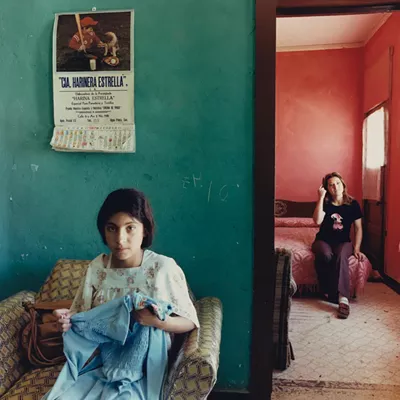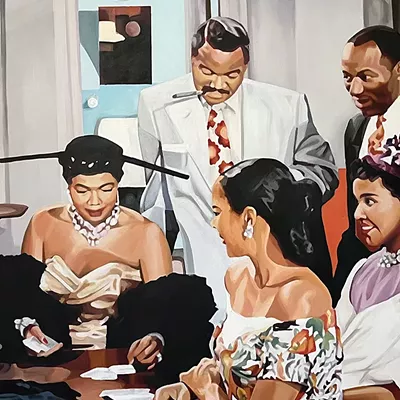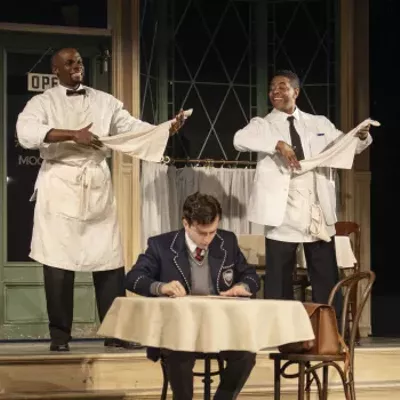It took a Nazi clampdown to turn John Gutmann into a photographer.
Gutmann's big retrospective at the Center for Creative Photography, some 118 photographs strong, is mostly about America from the 1930s to the 1980s. It's full of angular, off-center black-and-whites that delight in American street life, from its painted signs to its denizens of every race.
All of the pictures are unabashedly modernist works, with strange diagonals and odd points of view. In one, a living giant is being lowered down on ropes from a building in San Francisco. In another, a tribal school bus pulls just out of Gutmann's line of vision in the Arizona desert.
But Gutmann was a stranger in America; he'd imbibed the lessons of modernism back in his native Germany. He started out as a painter. At art school during the wild years of the Weimar Republic, Gutmann studied under the noted Expressionist artist Otto Müller, and he became an art star known for expressive, emotional works.
One painting from his student years in the mid-1920s, included in the show, is a loose ink-wash depicting the free-and-easy atmosphere of a German cabaret. Two women kissing passionately are locked in a long embrace in a booth, while a black man in tux and bowtie looks on.
As soon as he got out of school in 1927, Gutmann hightailed it to Berlin, the nation's cultural capital, where artists were turning out daring graphics and pointed political work. Gutmann's "Fischer Boys," a marvelous ink and pastel on paper from the early '30s, is a riveting, unpretty portrait of boys on a beach.
His art was exactly the kind that the Nazis hated. Hitler came to power in 1933, and shortly afterward, the Nazis began to suppress the "degenerate" art of the Expressionists, as guest curator Sally Stein describes in the informative book that accompanies the exhibition. The Nazis also banned the employment of "non-Aryans." Gutmann lost on both counts: He was a Jew and a "degenerate" artist.
But he was nothing if not enterprising. He got himself a decent camera, a Rolleiflex advertised as an easy-to-use "Photo-Automat," and taught himself to use it. He already had an eye and an aesthetic; all he had to do was learn the technology. He talked a photo agency into giving him press credentials as a freelance photojournalist, and he lit out for America.
The United States was in the depths of the Great Depression when Gutmann arrived in San Francisco, but the refugee photographer was delighted by his new land. In a self-portrait from that first year, he leans out his studio window on a high floor. He gazes out over the city, to the bay, to the mountains and the sky beyond. The vista is boundless, and so, the picture implies, are the opportunities. In nearly every photo from those early years, the sun shines brightly.
Gutmann traveled by bus all over the country, recording his pleasure in America's messy democracy. He photographed a giant car elevator in Chicago, two women roller-skating in New York, a high school student in rural California embracing his prize-winning chickens. Gutmann loved the sprawling populist vulgarity of America, its pyramid-shaped movie theaters, its cars and its god-awful billboards.
He was particularly entranced by street signs. In 1936, he discovered an automobile billboard in Detroit shaped exactly like the altar triptych in a Gothic cathedral—except that it was an homage not to God, but to capitalism. The word "Dodge" is at top center, where in Europe, you might expect to find a crucified Christ. On the side panels, instead of a weeping Virgin Mary and distraught apostles, the word "switch" is repeated over and over in an act of not-so-subliminal advertising. Gutmann called it "Switch to Dodge: An American Altar, Detroit."
Gutmann didn't shy away from America's dark side. He has affecting photos of marginalized black citizens, like a little girl in an inner-city California school, proud of her new dress, and a blind healer in Alabama. He photographed food lines, as well as street demonstrations and the disproportionate government response. A couple of cops haul a union organizer away in one picture, and "Artillery on Market Street, Armistice Parade, San Francisco," 1934, shows cannons rolling down the street in a show of force.
And there are portents of the coming war. A photo of three warplanes slicing through the sky is even titled "Omen."
"The News Photographer, San Francisco City Hall," 1935, records a visit by Nazi officials to San Francisco; the swastika hangs alongside Old Glory. Gutmann didn't have much luck selling his optimistic American shots to publications in Nazi-era Germany, but one German paper grabbed this one, printing it for its readers "as evidence of the international respect the Nazis enjoyed," Stein writes.
Gutmann enlisted in the Army at the age of 37, a year after the United States joined World War II. He served the military with his photography, and one shot of a huge Thanksgiving gathering of soldiers outdoors was picked up by Life magazine as a "Picture of the Week" in 1942. In China with the Army, he took many pictures of the dead and the destroyed. In one image, two shell-shocked Chinese women sit on a roadside curb in Kunming in 1944, babies in their laps.
Despite the fine plans he made as a young man, Gutmann struggled as a freelancer. He did commercial work—one delightful portrait of a young girl with a puckered-up smile was widely used in ads for pickles—and he published in assorted American magazines, including Look and The Saturday Evening Post. But he didn't achieve financial stability until he landed a job as a college professor. For years, he taught photography at the San Francisco State College, now San Francisco State University.
Gutmann's final chapter may be his most interesting. When he retired from full-time teaching 1973, the art world had changed. Photography had metamorphosed into a valued fine art, and collectors were keenly interested in Depression-era work. Now seen as a pioneering modernist, Gutmann got busy printing his works again, this time taking extra care with the quality. The prints were no longer meant for disposable newspapers; this time, they would hang on museum walls. He even re-named many of them, dreaming up arty new titles far removed from their journalistic origins.
"Refashion(ing) himself as the editor and archivist of his own earlier production," as former CCP director Doug Nickel writes in a foreword to the book, Gutmann exhibited widely in his old age and enjoyed critical acclaim. After his death in 1998, his archive went to the CCP.
Gutmann always debated in his own mind, Stein writes, whether his work was more German or American, whether it "derived the most strength from his early immersion in art or his artless embrace of raw life experience." The answer, as this exhibition of arresting photographs makes clear, is: all of the above.










